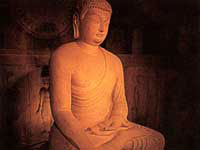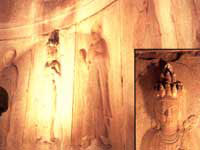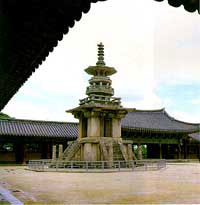World Heritage
World Heritage- Republic of Korea
-
Seokguram Grotto and Bulguksa Temple
Seokguram Grotto
The construction work for this grotto was started in 751 by Prime Minister Kim Daeseong during the reign of King Gyeongdeok of Silla and was completed in 774 during the reign of King Hyegong of Silla. At first, the name Seokbulsa was attached to it.
The grotto was built with white granite stone on the mid-slope of Tohamsan Mountain. The main Buddha placed inside the grotto is surrounded by a wall inscribed with 39 images including those of bodhisattvas, disciples, guardian deities, and Heavenly Kings. A path links the round main chamber of the grotto withthe rectangular front chamber. About 360 flat stones cover the dome-shaped ceiling, the likes of which cannot be found elsewhere in the world. Standing on each side of the rectangular front chamber are four images of heavenly guardians. Each side of the wall of the entrance is engraved with guardian deities. Each side of the walls of the path leading to the main chamber contains two images of the Four Heavenly Kings.
An octagonal stone column stands on each side of the entrance to the main chamber. The seated statue of the Main Buddha is placed a little behind the center of the round-shaped main chamber. Two images of heavenly guardians, two images of bodhisattvas, and ten images of Arhats fill the walls of both sides from the entrance. Placed right behind the Main Buddha is an image of the eleven-faced Avalokitesvara Bodhisattvas.
The images found inside this grotto are first-rate sculptural masterpieces. The image of the Main Buddha suggests advanced sculptural skill and near-perfect realistic expression. The image of the eleven-faced Avalokitesvara Bodhisattvas gives the impression of flamboyance. The images of the guardian deities, Four Heavenly Kings, and bodhisattvas display gallantry, dignity, and gracefulness, respectively. The images of Arhats are uniquely portrayed.
The Gupta-style Main Buddha statue placed in the main chamber is said to be an object of sublime esthetic quality. One feels the sublime mind deep inside his heart from the quiet cross-legged stance, the slumberous eyes, the gentle eyebrows, the middle of the forehead exuding wisdom, and the long ears.
Made during a prosperous period of the Silla Dynasty (57 BC-935 AD), this grotto is said to be a first-rate masterpiece. It was a product made by religious artists with architectural and geometric skills.
The grotto is preserved as a national treasure (National Treasure No. 24). Along with Bulguksa Temple, it was registered with the UNESCO as a world cultural heritage in December 1995.
The grotto facing the East Sea in a location deep inside Tohamsan Mountain in Gyeongju near the mountain top is known for its advanced sculptural skill and creative structure.Containing a total of 39 Buddha and bodhisattva images inside the white marble space, it is composed of the main chamber and the front chamber. The two chambers are linked through a path.
The rectangular front chamber contains images of eight supernatural guardians and guardian deities. The round-shaped main chamber, which is linked with the front chamber through a path whose wall is inscribed with the images of the Four Heavenly Kings, contains the statue of the Main Buddha. The following images are inscribed symmetrically on the wall of each side extending from the entrance: Brahman, Indra, Samantadhadra Bodhisattva, Manjusri Bodhisattva, and the ten principal disciples of Shakyamuni.
Part of Da-Tang Xiyuji (a narration of Xuan Zang's 17-year-long journey to Central Asia and India) written by Monk Xuanzang of (602-664) of the Tang Dynasty of China says, "The Temple of Enlightenment was set up on the very place where Shakyamuni obtained his enlightenment. A statue of Buddha, who obtained his enlightenment, was there. He sat facing the east, with his left foot resting on his right foot, his left hand placed on the inside of his thigh, and his right hand hanging down. The pedestal where the Main Buddha sits comes to 4 chi 2 cun in height and 1 zhang 2 chi 5 cun in width. The statue measures 1 zhang 1 chi 5 cun in height, with the width between the knees measuring 8 chi 8 cun and the shoulder width measuring 6 chi 2 cun." Since the Buddha statue that the monk saw does not exist, and said measurements coincide with those of the Main Buddha in Seokguram Grotto, it is suspected to be what he refers to in his narration.
Seated at the center of the round-shaped main chamber of the grotto, with the dome-shaped ceiling supposedly symbolizing the celestial body, is the 350 cm-high imposing figure of Shakyamuni with a genial facial expression, facing the East Sea.
His face that looks alive and the dynamically portrayed wrinkles of the robe hung only on the left shoulder add to the overall liveliness of the statue. He has slumberous eyes as if he is in meditation. His face shows dignity but wears a gentle smile. His left hand indicates the gesture of dhyana mudra. His right hand is placed on the lap with the forefinger pointing to the bottom, a gesture of subjugating demons.
Such image is the image of one having attained wisdom, i.e., one who has obtained victory by driving away demons’ obstructions and temptations.
The niche points to a mid-point between earth and heaven. It is associated with bodhisattvas as those between the Buddha and ordinary people. The image of Buddha Maitreya lends a sense of stability with the triangular layout among the right shoulder, wrist, and right knee. The curve made by its upright knees, arm put aslant on the lap, and face bent forward gives the impression of motion.
The images of the eight attendant deities protecting Buddha are made on the wall of the front chamber. The pair of guardian deities in skirts are portrayed as brave ones with well-developed upper body muscles.
Visitors are attracted to the exquisite figure of the image of the Eleven-Faced Avalokitesvara Bodhisattva right behind the Main Buddha statue of the main chamber.
The statue exudes an atmosphere of elaborateness and maturity. Its face displays a gentle smile. The gorgeous-looking head adornment, the naturally flowing robe, and the exquisitely portrayed fingers create a unique atmosphere.
Seokguram Grotto, which was made in the mid-8th century during a golden period of culture of the Unified Silla, shows that the sculptors were those who understood Buddhism deeply. The masterpiece was built based on advanced geometric, architectural, and esthetic sense. One feels magnanimity and sublimity from the images there amid the well-balanced ratio between said factors.The grotto is a structure portraying the moment Shakyamuni attained enlightenment with architectural and sculptural skills. The images look full of energy, and they are portrayed naturally with first-rate artistic skills without a trace of artificial techniques. By attaining enlightenment, Shakyamuni becomes a metaphysical figure Buddha, with the mundane world becoming a realm or a sphere (dhatu) of the Dharma or Absolute Reality. -
Bulguksa Temple
The construction work for Bulguksa Temple was started in 751 by Prime Minister Kim Daeseong during the reign of King Gyeongdeok of Silla and was completed in 774 during the reign of King Hyegong of Silla (i.e., same years of commencement and completion of work as Seokguram Grotto).
Located on a mid-slope west of Tohamsan Mountain, the temple is recognized as a monumental workpiece of art displaying deep Buddhist philosophy as well as the spirit of genius artists.
The temple is a result of the portrayal of Buddha land dreamt of by the people of Silla. The temple embodies Sakyamuni’s world of suffering based on the Sutra of the Lotus, Amitabha Buddha’s Land of Happiness based on the Infinite Life Sutra, and Vairocana Buddha’s world of universal lotus flower based on the Avatamsaka Sutra.The temple’s overall layout is divided into two areas: the area centered on the Main Hall, including Cheongungyo Bridge, Baegungyo Bridge, Jahamun Gate, Beomyeongru Pavilion, Jwagyeongru Pavilion, Dabotap Pagoda, Seoggatap Pagoda, Museoljeon Hall, etc., and; the other centered on Amitabha Buddha Hall, including Chilbogyo Bridge, Yeonhwagyo Bridge, Anyangmun Gate, etc.
The grandiose and unique stone structure that comes into view when you look at the temple in its front dates back to the time of its foundation in the 8th century. The wooden structure on the stone structure was refurbished in the 18th century after being destroyed during foreign invasion. The roofed corridors were those restored in the 1960s. Various well-trimmed stone parts including rectangular ones, arch-shaped ones, round columns, and balustrades were used for of the temple. Especially, the exquisite stone columns and balustrades of Chilbogyo/Yeonhwagyo Bridges make one marvel.
Experts speak highly of the three-tiered stone Seoggatap Pagoda (height: 8.2 m) for its well-proportioned body and simplistic yet grandiose structure and Dabotap Pagoda (height: 10.4 m) for its complex and flamboyant appearance and unique and creative expression techniques.
Bulguksa Temple is preserved as a historic site (Historic Site No. 502). Those designated as cultural heritage items include: Dabotap Pagoda (National Treasure No. 20), Seoggatap Pagoda (National Treasure No. 21), Cheongungyo and Baegungyo Bridges (National Treasure No. 23), Chilbogyo and Yeonhwagyo Bridges (National Treasure No. 22), Gilt-bronze Amitabha Buddha Statue (National Treasure No. 27), Vairocana Buddha Statue (National Treasure No. 26), etc. The temple, along with Seokguram Grotto, was registered with the UNESCO as a world cultural heritage in December 1995.



 >
>